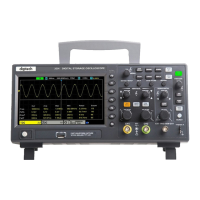User Manual
31
/
76
press the Custom softkey and turn the Multifunctional Knob to set the desired baud rate.
Parity: Parity Check. Choose odd, even, or none, based on your device under test.
Data Bits: Data Length, Set the number of bits to match your device under test. (selectable from 5-8 bits).
5. Press the When softkey and set up the desired trigger condition:
Start - The oscilloscope triggers when a start bit occurs.
Stop - Triggers when a stop bit occurs on measured signal. The trigger occurs on the first stop bit regardless of
using 1, 1.5 or 2 stop bit.
Spec Data - Triggers on a data byte that you specify. For use when the device under test data words are from 5 to
8 bits in length
a. Press the When softkey, and choose an equality qualifier. You can choose equal to(=), not equal to(!=),
less than(<), or greater than(>) a specific data value.
b. Press the Data softkey, and turn V0 to set the data value for your trigger comparison. The range of the data
value is 0x00 to 0xff. This works in conjunction with the When softkey.
Parity error: The oscilloscope triggers when the parity check is error when there is parity check.
Com error: The oscilloscope triggers when the received data is error.
Note: Use V0 to set the data. When the arrow shows vertical on the top left of Data menu, turn V0 to set the value of the
current data bit; then press V0, the arrow shows horizontal, and turn V0 to select the data bits that you want to set.
: Horizontal arrow, turn the Multifunctional Knob to select a digit.
: arrow, turn the Multifunctional Knob to set the value of the selected digit.
6. Press the Mode softkey, turn V0 to select the trigger mode (auto, normal), and press V0 to confirm.
Auto: When the oscilloscope meets the trigger condition, it completes a trigger acquisition once; when the trigger condition
is not met, it can run the acquisition waveform freely.
Normal: When the oscilloscope meets the trigger condition, the input waveform is displayed; when the trigger condition is
not met, the original waveform is displayed.
7. Press the Holdoff softkey and turn V0 to set the time that the oscilloscope waits before a trigger to the next trigger, so that
complex waveforms are displayed stably.
2.7.11. LIN Trigger
LIN triggering can trigger on the rising edge at the Sync Break exit of the LIN single-wire bus signal (that marks the
beginning of the message frame), the Frame ID, or the Frame ID and Data.
Set LIN trigger:
1. Press the [Trig Menu] button on the front panel to enter the Trigger system function menu.
2. Press the Type softkey, then turn the Multifunctional Knob to select LIN and push down the knob to confirm.

